Header Image from National Park Service Katahdin Woods and Waters National Monument, Maine.
Maine admitted March 15, 1820
as the 23rd state.
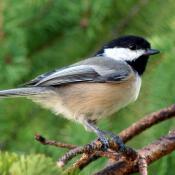 Bird: Chickadee – The chickadee makes at least 15 different calls to communicate with its flock-mates and offspring. The best known is the chickadee-dee-dee that gives the bird its name. The more “dee” sounds, the greater the danger. One chickadee has been observed to call with 23 “dee” sounds in the presence of a predator owl. Chickadees live in small groups and establish a dominance hierarchy, or “pecking order.” Each bird is known to the other according to rank which is set by its degree of aggressiveness. Accordingly, all the birds in the flock are subordinate to the most aggressive bird; and the lowest ranking bird is subordinate to all the others. When breeding season begins, the tiny brains of chickadees and other songbirds enlarge to enable the birds to create more sounds.
Bird: Chickadee – The chickadee makes at least 15 different calls to communicate with its flock-mates and offspring. The best known is the chickadee-dee-dee that gives the bird its name. The more “dee” sounds, the greater the danger. One chickadee has been observed to call with 23 “dee” sounds in the presence of a predator owl. Chickadees live in small groups and establish a dominance hierarchy, or “pecking order.” Each bird is known to the other according to rank which is set by its degree of aggressiveness. Accordingly, all the birds in the flock are subordinate to the most aggressive bird; and the lowest ranking bird is subordinate to all the others. When breeding season begins, the tiny brains of chickadees and other songbirds enlarge to enable the birds to create more sounds.
It is the state bird of both Maine and Massachusetts in the United States, and the provincial bird of New Brunswick in Canada.
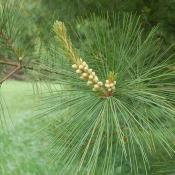 Flower: White pine cone & tassel – Botanically, the white pine cone and tassel are not flowers. Lawmakers chose the White Pine Cone because the state was commonly known as the Pine Tree state.
Flower: White pine cone & tassel – Botanically, the white pine cone and tassel are not flowers. Lawmakers chose the White Pine Cone because the state was commonly known as the Pine Tree state.
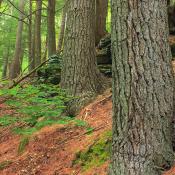 Tree: White pine – Henry David Thoreau said “There is no finer tree.”
Tree: White pine – Henry David Thoreau said “There is no finer tree.”
In the 19th century, the harvesting of Midwestern white pine forests played a major role in America’s westward expansion through the Great Plains. A quarter million white pines were harvested and sent to lumber yards in Chicago in a single year. Although eastern white pine was frequently used for flooring in buildings constructed before the U.S. Civil War, the wood is soft and will tend to cup over time with wear. George Washington opted for the much harder southern yellow pine at Mount Vernon instead. During colonial times, its strong, straight trunks were used to make masts for ships sailing in the British Royal Navy.
State Quarter
From theus50.com
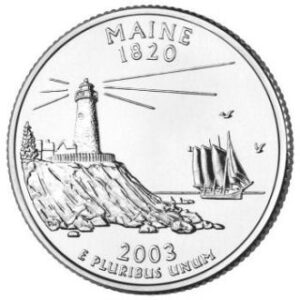
Maine became the 23rd state to be admitted into the Union, as part of the Missouri Compromise on March 15, 1820. The Maine quarter design incorporates a rendition of the Pemaquid Point Light atop a granite coast and of a schooner at sea.
Pemaquid Point Light is located in New Harbor, and marks the entrance to Muscongus Bay and Johns Bay. Since the beginning of ship activity in the area, a shoal created hazardous navigation conditions, causing many shipwrecks. As maritime trade increased in the area, so did the need for a lighthouse. In 1826, Congress appropriated funds to build a lighthouse at Pemaquid Point. Although the original building was replaced in 1835, and the original 10 lamps in 1856, the light is still a beacon for ships and remains one of Maine’s most popular tourist attractions. The schooner resembles “Victory Chimes, ” the last three-masted schooner of the Windjammer Fleet. “Victory Chimes” has become synonymous with Maine windjamming.
Capital: Augusta, Maine – Maine’s capital city, Augusta, is named after the daughter of Revolutionary War hero, Henry Dearborn.
Nickname: Pine Tree State – the eastern white pine appears on the state flag, seal, and Maine quarter.
Motto: I direct
Maine’s official state animal is the moose
 The official cat of Maine is the hefty Maine Coon. Likely the oldest cat breed in America, this large-sized, fluffy cat is sometimes mistaken for a bobcat.
The official cat of Maine is the hefty Maine Coon. Likely the oldest cat breed in America, this large-sized, fluffy cat is sometimes mistaken for a bobcat.
Maine Facts and Trivia
Maine is another case where no one is quite sure how the name came about. Ferdinando Gorges and John Mason, who received a charter for land in Maine, were both English Royal Navy veterans, and the name may have originated with the sailors differentiating “the mainland” from the many islands off the state’s coast.
Maine’s state legislature, meanwhile, passed a resolution in 2001 that established Franco-American Day and claimed that the state was named after the French province of Maine.
The first European settlement in Maine was established by Frenchmen Pierre du Guast and Samuel de Champlain on St. Croix Island in 1604. They founded a colony called Acadia which included part of Maine and modern day Quebec, Canada.
An unsuccessful attempt at establishing a permanent English settlement in the New World was at the location now known as Popham Beach. Sir George Popham led the expedition in 1607.
In 1652, the land became part of the Massachusetts Bay Colony of England. It would remain part of Massachusetts until 1820. Over the years the French and English fought for control of the region. England finally gained control at the end of the French and Indian War in 1763
One of the reasons that Maine was admitted as a state was because of the Missouri Compromise of 1820. This agreement said that there should be an equal number of slave states and free states. When Missouri was admitted as a slave state, Maine was admitted as a free state to keep the balance even.
West Quoddy Head is the most easterly point in the United States.
Maine is the only state in the United States whose name has one syllable.
Maine is the only state that shares its border with only one other state (New Hampshire).
Off the northwest coast of Maine is an island called Machias Seal Island. Because both the United States and Canada claim the island, anyone born on the island can claim dual citizenship.
 Approximately 40 millions pounds (nearly 90 percent) of the nation’s lobster supply is caught off the coast of Maine.
Approximately 40 millions pounds (nearly 90 percent) of the nation’s lobster supply is caught off the coast of Maine.
 Maine produces 99% of all the blueberries in the country making it the single largest producer of blueberries in the United States.
Maine produces 99% of all the blueberries in the country making it the single largest producer of blueberries in the United States.
90% of the country’s toothpick supply is produced in Maine.
Donut holes were invented in Maine. The first donuts in America did not have holes. They were introduced by the Dutch who fried dough in hot oil, but they often cooked unevenly with the center staying raw.
Capt. Hansen Gregory, from Rockport, Maine came up with the solution of punching a hole in the center while working as a 16-year-old crewman on a lime-trading schooner in 1847.
With a total area of 33,215 square miles the state covers nearly as many square miles as the other five New England states combined.
The coastline boasts so many deep harbors it is thought all the navies in the world could anchor in them.
Maine Cities
Augusta is the most eastern capital city in the United States.
Bath is known as the City of Ships.
Eastport is the most eastern city in the United States. The city is considered the first place in the United States to receive the rays of the morning sun.
Eastport is the only United States owned principality that has been under rule by a foreign government. It was held from 1814 to 1818 by British troops under King George following the conclusion of the War of 1812.
Freeport is the home to the L.L. Bean Company.
Former President George H. W. Bush had a summer home in Kennebunkport
Portland was first temporarily selected as the state capital. In 1832 the capital was moved to the centrally located site of Augusta.
Togus was the first Veteran’s Hospital in the United States. The facility was founded in 1866.
In Wilton there’s a cannery that imports and cans only dandelion greens.
The nation’s first sawmill was established near York in 1623.
York became the nation’s first incorporated city in 1642.
Maine Strange Laws
Shotguns are required to be taken to church in the event of a Native American attack.
You may not step out of a plane in flight.
After January 14th you will be charged a fine for having your Christmas decorations still up.
Bullets may not be used as currency.
It is illegal to advertise in a cemetery.
It is illegal to keep an armadillo as a pet in Maine.
People
- Joshua L. Chamberlain, born in Brewer received the only battlefield promotion to General during the Civil War. He was also the last Civil War soldier to die of wounds incurred in the War.
- Dorothea Dix, civil rights reformer
- Dustin Farnum, actor
- John Ford, film director
- Melville Fuller, jurist
- Marsden Hartley, painter
- Sarah Orne Jewett, author
- Stephen King, writer
- Linda Lavin, actress
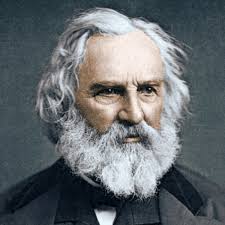 Henry Wadsworth Longfellow, poet
Henry Wadsworth Longfellow, poet
Portland is the birthplace of poet Henry Wadsworth Longfellow.The writer was born in Portland, on February 2, 1807. His most popular works include “The Courtship of Miles Standish”, “Evangeline” and “Hiawatha”.- Hiram Stevens Maxim, inventor
- Edna St. Vincent Millay, poet
- Marston Morse, mathematician
- Frank Munsey, publisher
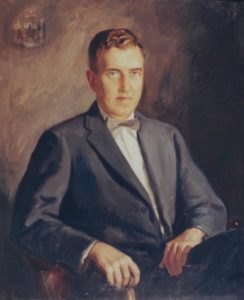 Edmund S. Muskie became the first Democratic United States senator ever elected by popular vote in Maine. He was also elected governor for two terms. He was the Democratic Party’s candidate for Vice President of the United States in the 1968 election.
Edmund S. Muskie became the first Democratic United States senator ever elected by popular vote in Maine. He was also elected governor for two terms. He was the Democratic Party’s candidate for Vice President of the United States in the 1968 election.- Walter Piston, composer
- George Palmer Putnam, publisher
- Kenneth Roberts, historical author
- Edwin Arlington Robinson, poet
- Margaret Chase Smith, politician
- Percy Lebaron Spencer, inventor of the microwave
- Francis Stanley and his brother, Freelan Stanley, inventors of the Stanley Motor Carriage Company which built the Stanley Steamer
- John Hay Whitney, publisher
Credits
See State Symbols
See Mental Floss.com
See 50 states.com
See History.com
See Chowdaheadz.com
See Fact retriever.com
See Ducksters.com
***Nelson, Ken. “Maine State History for Kids.” Ducksters, Technological Solutions, Inc. (TSI), www.ducksters.com/geography/us_states/maine_history.php. Accessed 17 February 2019.
See Tidbits of History.com/states for facts and trivia about each of the states.

Pingback: This day in history, March 15